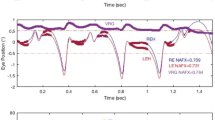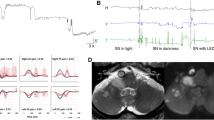Abstract
Patients with congenital nystagmus (CN) are unable to respond adequately to optokinetic stimuli. This suggests that patients with CN do not use the movement of images (slip) across the retina as a control variable for their eye movements. Nevertheless, they are capable of tracking moving targets with slow eye movements. Experiments using paracentral afterimages as targets for fixation suggest that these slow tracking movements may be executed by the control of target position on the retina rather than slip across the retina: all seven patients with CN produced slow tracking movements, superimposed on nystagmic cycles. The fact that the basic parameters of the CN waveform remained unchanged under the open-loop condition constituted by afterimage tracking (only the amplitude was reduced in four out of seven patients) indicates that the timing and direction of slow and rapid components of CN do not depend on retinal feedback. During refixations between stationary targets, some patients with CN occasionally acquired the target with a slow, rather than a saccadic movement. This finding further supports the notion that patients with CN use target offset from the fovea as a very effective control variable not only for rapid, but also for slow eye movements.
Similar content being viewed by others
References
Abadi RV, Dickinson CM (1985) The influence of preexisting oscillations on the binocular optokinetic response. Ann Neurol 17:578–586
Abadi RV, Dickinson CM, Lomas MS (1982) Inverted and asymmetrical optokinetic nystagmus. In: Lennerstrand G, Zee DS, Keller EL (eds) Functional basis of ocular motility disorders. Pergamon Press, Oxford, pp 143–146
Cüppers C, Sevrin G (1956) Le problème de la fixation dans l'amblyopie et particulièrement dans le nystagmus. Bull Mem Soc Fr Ophtalmol 69:359–366
Dell'Osso LF, Abel LA (1985) The smooth pursuit system in CN is normal. Invest Ophthalmol Vis Sci [Suppl] 26:46
Dell'Osso LF, Gauthier G, Liberman G, Stark L (1972) Eye movement recordings as a diagnostic tool in a case of congenital nystagmus. Am J Opt Am Acad Opt 49:3–13
Halmagyi GM, Gresty MA, Leech J (1980) Reversed optokinetic nystagmus (OKN), mechanism and clinical significance. Ann Neurol 7:429–435
Jung R, Kornhuber HH (1964) Results of electronystagmography in man: the value of optokinetic, vestibular, and spontaneous nystagmus for neurologic diagnosis and research. In: Bender MB (ed) The oculomotor system. Harper and Row, New York, pp 428–482
Kommerell G (1984) Congenital nystagmus, characteristics and pathophysiology. In: Ravault AP, Lenk M (eds) Trans Fifth International Orthoptic Congress. LIPS, Lyon, pp 345–351
Kommerell G, Klein U (1971) Über die visuelle Regelung der Okulomotorik: Die optomotorische Wirkung exzentrischer Nachbilder. Vision Res 11:905–920
Kommerell G, Täumer R (1972) Investigations of the eye tracking system through stabilized retinal images. Bibliotheca Ophthalmologica, vol 82. Karger, Basel, pp 288–297
Kommerell G, Mehdorn E (1982) Is an optokinetic defect the cause of congenital and latent nystagmus? In: Lennerstrand G, Zee DS, Keller EL (eds) Functional basis of ocular motility disorders. Pergamon Press, Oxford, pp 159–167
Kommerell G, Horn R, Bach M (1986) Motion perception in congenital nystagmus. In: Keller EL, Zee DS (eds) Adaptive processes in visual and oculomotor systems. Pergamon Press, Oxford (in press)
Optican LM, Zee DS (1984) A hypothetical explanation of congenital nystagmus. Biol Cybern 50:119–134
Optican LM, Zee DS, Chu FC, Cogan DG (1983) Open loop pursuit in congenital nystagmus. ARVO Abstracts [Suppl] Invest Ophthalmol Vis Sci 24:271
Wyatt HJ, Pola J (1981) Slow eye movements to eccentric targets. Invest Ophthalmol Vis Sci 21:477–483
Yamazaki A (1979) Abnormalities of smooth pursuit and vestibular eye movements in congenital jerk nystagmus. In: Shimizu K (ed) Ophthalmology, vol 2, Excerpta Medica, Amsterdam, pp 1162–1165
Yee RD, Baloh RW, Honrubia V (1980) Study of congenital nystagmus: optokinetic nystagmus. Br J Ophthalmol 64:926–932
Author information
Authors and Affiliations
Additional information
Reported in part at the Joint World Meeting of Neuroophthalmology, Antwerp, 1984
Rights and permissions
About this article
Cite this article
Kommerell, G. Congenital nystagmus: control of slow tracking movements by target offset from the fovea. Graefe's Arch Clin Exp Ophthalmol 224, 295–298 (1986). https://doi.org/10.1007/BF02143074
Received:
Accepted:
Issue Date:
DOI: https://doi.org/10.1007/BF02143074




